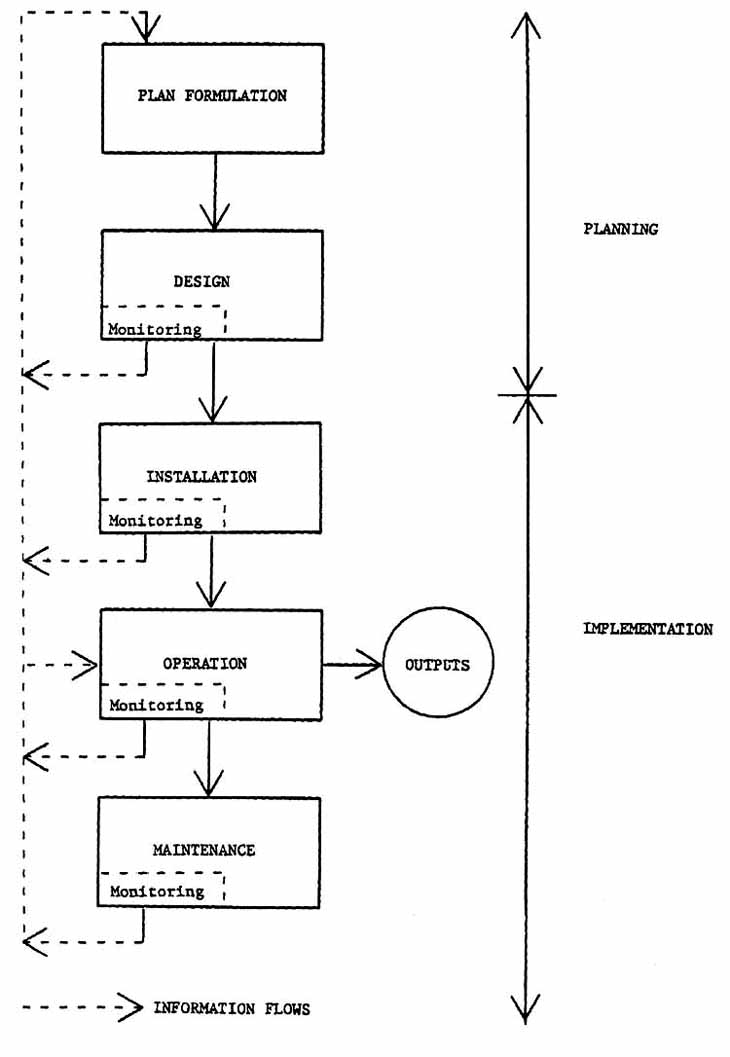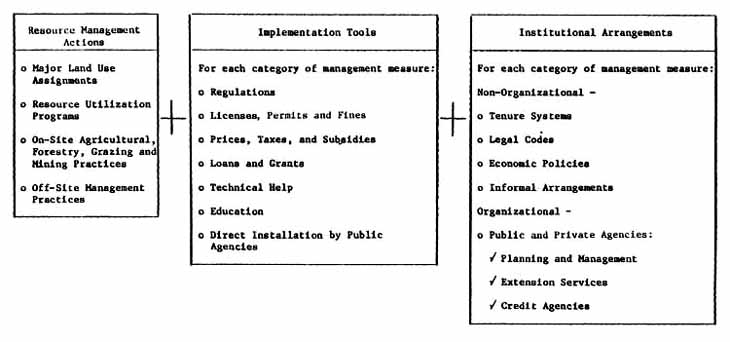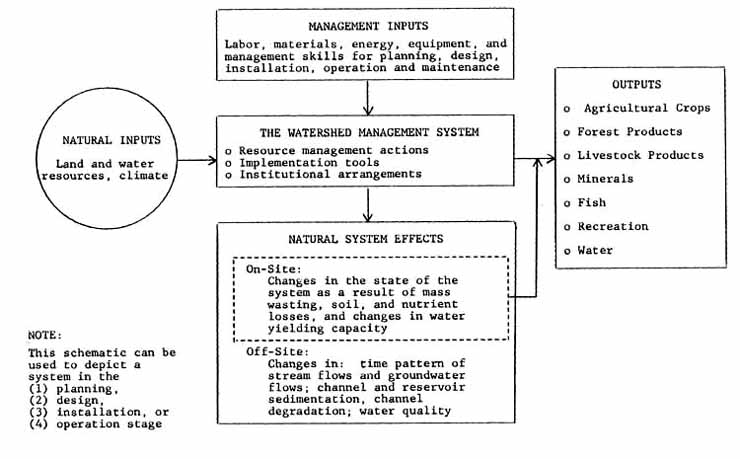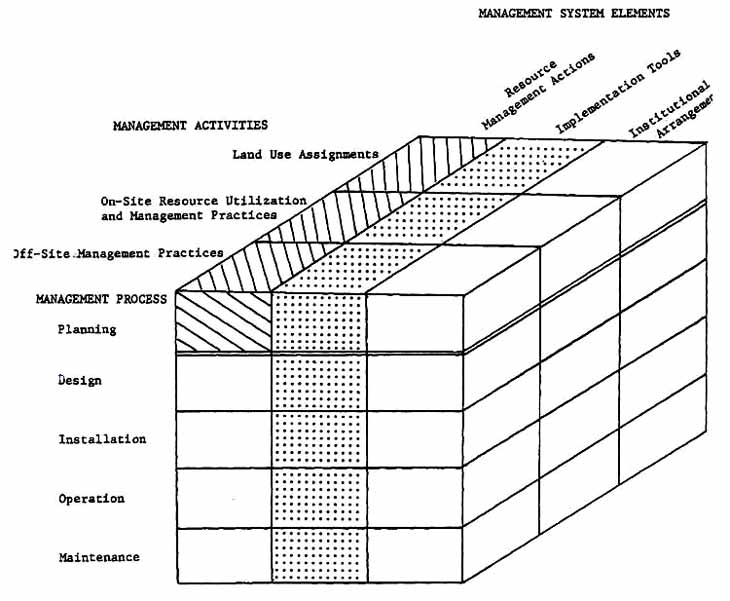A CONCEPTUAL FRAMEWORK FOR ANALYSIS OF WATERSHED MANAGEMENT ACTIVITIES
Maynard M. Hufschmidt, Fellow
Environment and Policy Institute
East-West Center, Honolulu, Hawaii
SUMMARY
A conceptual framework is needed to help sort out the important problems and issues which arise in watershed management. The framework presented here is considered to be equally valid when the watershed approach is used in planning and implementing a wide range of sectoral projects such as: agriculture, forestry, energy, mining, transportation, human settlements, and fisheries and wildlife. It is intended to provide a convenient means for identifying the major watershed management problems in developing countries and for designing a research agenda to help find solutions.
INTRODUCTION
This conceptual framework is offered as one way of sorting out many of the important problems and issues that arise as watershed management projects and programs are planned and carried out. This particular framework is based on work done at the East-West Center on natural systems assessment and valuation and on water resources management over the past five years (Carpenter 1983, Hufschmidt et al. 1983, Bower and Hufschmidt 1984). As such it represents an adaptation of several conceptual models and approaches to the specific case of watershed management. We make no claim that this framework is the only valid way of conceptualizing watershed management; merely that it provides one approach to analysis of the questions and issues that arise as we seek to identify the major watershed management problems in developing countries and develop a research agenda to help in their solution.
For purposes of this paper, watershed management is defined as the process of formulating and carrying out a course of action involving manipulation of the natural system of a watershed to achieve specified objectives. In the case of a forested watershed, sound forest management would, for practical purposes, be synonymous with watershed management.
MAJOR ELEMENTS OF THE FRAMEWORK
Consistent with this definition of watershed management, the framework consists of three elements or dimensions, each of which represents a different analytical approach to watershed management, yet each of which is also related to the two other approaches. This approach considers:
i) watershed management as a process involving separate but closely linked stages of planning and implementation.
ii) watershed management as a planned system of management measures and implementation tools applied to a watershed through a set of institutional/organizational arrangements.
iii) watershed management as a set of linked activities for which specific management tasks are required.
THE PROCESS OF WATERSHED MANAGEMENT
Figure 1 presents, in simplified form, the conventional delineation of watershed management as sequential steps of planning, design, installation, operation and maintenance, with monitoring and feedback of information to earlier steps of the process. This conforms to the realities of many water and land resource management activities in developing countries, where the project is the major decision unit. In the classical case in a developing country, watershed management begins with the perception of a problem such as deterioration of land and water resources, or a resource management task such as forest management which leads to a decision to prepare a project or program plan. Plan formulation leads to the preparation of a project feasibility report which provides the basis for a decision to implement the project. The planning stage is completed with the design of the project. Typically, implementation begins with installation of watershed resource utilization and management practices, often involving substantial capital expenditures. This stage of implementation (which may involve detailed designs) may take several years and is followed by an ongoing program of utilization, including operation and maintenance, of the land resource and facilities, which may continue indefinitely, at least until some major natural or social perturbation requires a change.
Figure 1. The five stages of integrated watershed management.

There is no conceptual reason why planning should be a major, separate step in watershed management, often far removed in time from implementation. Planning and implementation could proceed more or less in tandem, with information gained in implementation fed back promptly into planning. Yet this rarely seems to be the case for watershed management projects in developing countries. For example, implementation of the Mae Chaem Watershed Development Project, on 4,200 sq kin of upland used primarily for agriculture in northern Thailand, was preceded by seven years of planning (Roth et al. 1983).
Looking at watershed management as a process helps us to understand how planning and implementation must be meshed if management is to be effective. For example, lessons learned from monitoring performance during the implementation stage would be used to make appropriate revisions in management programs.
WATERSHED MANAGEMENT AS A PLANNED SYSTEM
In this approach watershed management is seen as a planned system of:
i) resource management actions including land uses, on-site resource utilization
and management practices, and off-site management practices;
ii) implementation tools for carrying out the management measures through public and private actors; and
iii) a set of institutional arrangements within which implementation proceeds.
A simplified depiction of this approach is shown in Figure 2.
There are two important points to be made about this way of looking at watershed management. The first is the clear distinction drawn between management measures -"things to be done" -and implementation tools -- "ways of getting things done." Watershed management planners often concentrate on formulating alternative packages of resource management actions without formulating alternative packages of implementation tools to an equivalent level of detail, including determination of who is to take resource management actions and who is to apply the implementation tools. This often results in neglect of the problems of implementation at the planning stage of watershed management.
The second point is that institutional arrangements -- both "rules of the game" and organizational -- are included within the scope of the planned system. Again, this serves to highlight the key role of institutions in the success or failure of implementing watershed management plans.
Clearly, effective watershed management requires that problems and issues of implementation and institutions be addressed at the planning stage along with the physicallyoriented management measures. This second dimension of watershed management highlights this requirement.
Figure 2. Watershed management as a planned system.

In a somewhat broader context, in physical output terms only, watershed management can be seen as a system which uses management inputs along with natural inputs to produce outputs of useful goods and services, with consequent on-site and off-site effects on natural systems. The schematic of these systemic relationships is shown in Figure 3.
Several useful insights flow from this schematic. From the economic point of view, the watershed management system is a particular kind of production process in which economic costs are incurred by use of management and natural inputs, and economic benefits are gained from the resultant outputs. Depending on the nature of the resulting on-site and off-site natural systems effects, additional economic costs or benefits are generated. In this way the schematic highlights the principal elements of a benefit-cost analysis.
The schematic also distinguishes between the on-site and off-site natural system effects. To the extent that watershed management reduces adverse on-site effects on soil and vegetation such as soil and nutrient losses, it will have a positive effect on maintaining or increasing outputs. Most of the economic benefits of improving on-site conditions will be in the form of maintaining or increasing levels of on-site outputs.
Measurement of off-site (downstream) effects on natural systems will require a separate physical and economic analysis that extends beyond the physical boundaries of the management area.
Of course, determination of what are on-site and off-site effects depends on how the boundaries of the watershed system and its subsystems are delineated. To the extent possible, boundaries should be established so that all major effects are internalized within the system. Establishment of the appropriate boundaries for a watershed management program is a crucial early step in the management process. The schematic shown in Figure 3 highlights the importance of this step.
ACTIVITIES AND TASKS OF WATERSHED MANAGEMENT
From this viewpoint, watershed management can be subdivided for analytical purposes into a number of specific steps that watershed management agencies or other actors must perform to produce the desired outputs and effects on the natural system. These steps can be identified by analyzing watershed management as a set of linked activities for which specific management tasks are required.
For example, as a first activity, the entire watershed area must be subdivided into various types of existing or prospective major land uses: agriculture, grazing, agroforest, commercial forest, protection forest, mining, transportation, urban. Of course, for each of these types, these may be multiple uses; for example, a commercial forest may be used for grazing, wildlife, and recreation as well as for wood products. Next, for each operating unit in a given type of land use the on-site resource utilization and management practices must be developed. For agriculture this would include the types, rotations and time patterns of crops and other outputs, the quantity and time patterns of resource inputs such as water, fertilizer, labor and machinery, methods of tilling, e.g., contour plowing, methods of application of water, fertilizers and pesticides, and construction and maintenance of buffer strips, grassed waterways, terraces, and on-farm check dams. For commercial forests this would include tree species to be grown and harvested, rotation policy, quantity, location and timing of major resource inputs, including logging roads, methods of tree planting, thinning and fertilizing, methods of harvesting, siting of roads, and water handling practices on roads, skid trails and landings.
Finally, to further reduce adverse downstream effects of the on-site land use activities, a set of off-site management practices would be undertaken instream and along stream borders. These include structural measures, such as sluices in reservoir diversion gates, channel improvements, and stream bank protection by riparian buffer strip preservation, revegetation or riprapping.
Figure 4 provides a summary with examples of content of each activity.
Figure 3. Schematic of a generalized watershed management system in physical output

Figure 4. The three major activities of watershed management.
1. Subdivision of watershed area into major types of land use, such as:
| Agriculture |
| Irrigated |
| Rain-fed |
| Grazing |
| Agroforestry |
| Forest |
| Commercial |
| Mixed-use |
| Preservation |
| Mining |
| Transportation |
| Urban |
| Lakes, Reservoirs and |
| Stream Channels |
2. Development of program of resource utilization and management practices
for each operating unit within each type of major land use. Examples are:
| Irrigated Agriculture | Agroforestry | Commercial Forest |
| Types of crops Rotation of crops Quantity and timing of Water, fertilizer, pesticides, labor, animal-Power and machinery inputs. |
Types, spatial distribution, and rotation
of tree and row crops. Quantity and timing of resource inputs. |
Types of tree species. Rotation and spatial distribution of tree crops. Quantity and timing of resource inputs. |
| Methods of tilling contour Plowing. | Methods of tilling and tree cropping. | Methods of tree planting, thinning and fertilizing. |
| Methods of application of Water, fertilizer
and Pesticides. Installation and maintenance of buffer strips, grassed Waterways, terraces, On-farm, check dams. |
Mehtods of application of water, fertilizers
and pesticides. Installation and maintenance of erosion control measures, road siting, construction and maintenance. |
Harvesting methods, erosion control practices, road siting, construction. |
3. Development of a set of downstream management practices. Examples include:
| Stream bank protection by reserve buffer strips, revegetation and riprapping |
| Debris removal |
| Channel dredging |
| Harbor estuary dredging |
| Treatment of intake water |
| Wastewater treatment |
APPLICATION OF THE ANALYTICAL FRAMEWORK
Each of the three dimensions represents a different analytical "cut" or dimension of the watershed management problems. Taken together, they form a three-dimensional analytical framework that can be depicted as a cube in Figure 5.
This cube has 45 individual cells, each of which could provide a basis for analysis. If we assume that the unit of analysis in each cell is the task, the following types of questions can be asked: What specific tasks are required to plan for major land use assignments? What tasks are required to provide implementation tools for the installation of resource utilization programs? In theory an investigation of the content of each of the 45 cells would be required for a complete management analysis. In fact, however, the content of many of the cells may have little management significance.
It is appropriate, therefore, to approach the analytical task by constructing two-dimensional tables of the type shown in Figure 6 and selectively analyzing certain cells of the table that are considered to be of special interest. For example, if the focus of concern is on resource management actions ("things to be done") at the planning stage (the set of crosshatched blocks in Figure 5), one could start by identifying the tasks that are required to plan for major land-use assignments. This list might include:
Land capability analysis Land suitability analysis Formulation and benefit-cost
analysis of alternative land use plans (including assumptions as to associated
management practices)
If desired, the analysis of management actions at the planning stage could
be extended to the second block of the cross-hatched set in Figure 5 to
identify the tasks needed to plan for the management actions needed for
on-site resource utilization and land management practices for one or
more specific land uses. For example, for agroforestry there would be
forestry, agronomic and economic analyses of types, spatial distribution,
and rotation of tree and row crops, and planning for methods of tilling
and cropping and for erosion control practices. The analysis could be
extended further to identify tasks needed to plan for offsite management
practices for agroforestry and other land uses.
Further extension to the entire "planning" slice (the top 12 boxes) of Figure 5 would allow one to identify all of the tasks required at the planning stage, to formulate a set of management actions, implementation tools, and institutional arrangements, as shown in Figure 6. Such a checklist of tasks would be extremely useful both in setting up a program for undertaking a watershed management plan and for ex post analysis of plans. The checklist highlights the importance of making specific plans for implementation tasks and for institutional arrangements.
Other starting points for analysis could be selected from Figure 5. Thus, if one were interested in analyzing implementation tools at the installation stage one could begin by identifying the tasks required to install on-site resource utilization and management practices for specific land uses. (This would be a block in the interior of the dotted vertical "slice" shown in Figure 5). As shown in the outlined box in Figure 7, such tasks might include technical help for crop planting, fertilizing, irrigation, harvesting and erosion control practices; economic incentives, marketing assistance, and regulation. Tasks involving implementation tools could also be identified for the planning, design, operation and maintenance stages of the management process. The analysis of implementation tools could be further extended by filling in the first and third columns of Figure 7, thus providing complete coverage of tasks involving implementation tools (the dotted vertical "slice" in Figure 5).
ROLE OF THE ANALYTICAL FRAMEWORK
The analytical framework is both a diagnostic and a planning tool which relies upon disaggregation of management into specific tasks that can be analyzed along the three dimensions. The analysis can be simplified by starting with one dimension, for example, the management process and, for each element of that dimension (for example, planning, design, installation, operation and maintenance), constructing a table with columns and rows identified with the other two dimensions (for example, management system elements and management activities). Figure 6 is an example of one such table. The boxes in the tables are then filled in with the specific tasks identified with respect to the three dimensions.
Figure 5. A three-dimensional analytical framework for watershed management.

Figure 6. Examples of watershed management tasks required at the planning stage, classified by management activities and management system elements.
| MANAGEMENT ACTIVITIES | MANAGEMENT SYSTEM ELEMENTS | RESOURCE MANAGEMENT ACTIONS | IMPLEMENTATION TOOLS | INSTITUTIONAL ARRANGEMENTS |
| LAND USE ASSIGNMENT | Land capability analysis Land suitability analysis Formulation and benefit- cost analysis of alternative land-use plans |
Planning for Regulation Economic incentives Education |
Planning for: Ownership/tenure systems Public regulation systems Organizational changes |
|
| ON-SITE UTILIZATION AND MANAGEMENT PRACTICES | For agroforestry: Agronomic,forestry, and economic analyses of types, distribution and rotation of tree and row crops Planning f or methods of tilling, methods of cropping, erosion control practices |
Planning f or: Education Technical help Economic incentives Marketing assistance Regulation |
Planning for: Extension services Credit/financial aid Ownership/tenure systems Soil Conservation Agency |
|
| OFF-SITE MANAGEMENT PRACTICES | Planning for: Stream bank vegetation, protection or revegetation Channel dredging |
Planning f or: Education Technical help Economic incentives Public installation and maintenance |
Planning f or: Extension services Credit/financial aid systems Soil conservation agency |
|
Figure 7. Examples of tasks involving implementation tools, classified by stages of the management process and management activities.
| MANAGEMENT PROCESS MANAGEMENT
|
LAM USE ASSIGNMENTS | ON-SITE RESOURCE UTILIZATION MANAGEMENT PRACTICES | OFF-SITE MANAGEMENT PRACTICES | |
| PLANNING | Content, magnitude and timing of
Education |
|||
| DESIGN | Detailed design of programs for
Technical help |
|||
| INSTALLATION |
|
|||
| OPERATION | Monitoring of performance Technical help on changes in utilization plans Economic incentives Marketing assistance Regulation |
|||
| MAINTENANCE | Technical help economic incentives and regulation for maintaining productive plant and facilities |
The analytical framework enables one to isolate specific parts of watershed
management for examination in detail, and provides a useful basis for
study of specific watershed management experiences. For example, a case
study using this analytical framework may show that major emphasis is
placed on installation of management facilities, to the neglect of operation
and maintenance, or that planning for resource management actions receives
much more attention than planning for implementation tools and institutional
arrangements. By means of such analysis, management failures can be traced
specifically to inadequacies in planning as related to specific activities
and tasks.
THE ROLE OF INSTITUTIONS
There are many reasons for inadequacies in watershed management depending upon the particular situation at the particular time in the particular country in question. But available evidence indicates the great importance of institutions -- both organizational and nonorganizational -- for effectiveness in watershed management.
A typical situation encountered in many Asian countries is the fragmentation of watershed management activities among a number of public sectorial agencies as well as private enterprises. Thus, upstream watershed management responsibilities may be lodged in the Ministry of Forestry, but usually may be shared with the Ministry of Agriculture. The Ministries of Irrigation and Energy also may have major responsibilities in specific cases involving Watersheds above reservoirs. Other governmental entities that may be involved include those concerned with public works industry, land reform, rural development and local government. Added to this are the ;any private, individual and non-governmental cooperative groups that are dependent on the resources of the watershed for their sustenance.
It is especially important, therefore, that any conceptual framework for diagnosis of watershed management be able to deal. with the institutional dimension. As shown graphically in Figure 5, the conceptual framework presented in this paper enables this to be done.
REFERENCES
Bower, Blair T. and Maynard M. Hufschmidt. 1984. A conceptual framework for analysis of water resources management in Asia. Natural Resources Forum, 8(4):343-355.
Carpenter, Richard A. (ed.). 1983. Natural Systems for Development: What Planners Need to Know. New York: MacMillan Publishing Co.
Hufschmidt, Maynard M., David E. James, Anton, D. Meister, Blair T. Bower, and John D. Dixon. 1983. Environment, Natural Systems, and Development: An Economic Valuation Guide. Baltimore: The Johns Hopkins University Press.
Roth, Alan D., Lynn Hewitt, Michael Carroll and Kasem Chunkao. 1983. Evaluation of Mae Chaem Watershed Development Project. Washington, D.C. Development Alternatives, Inc.